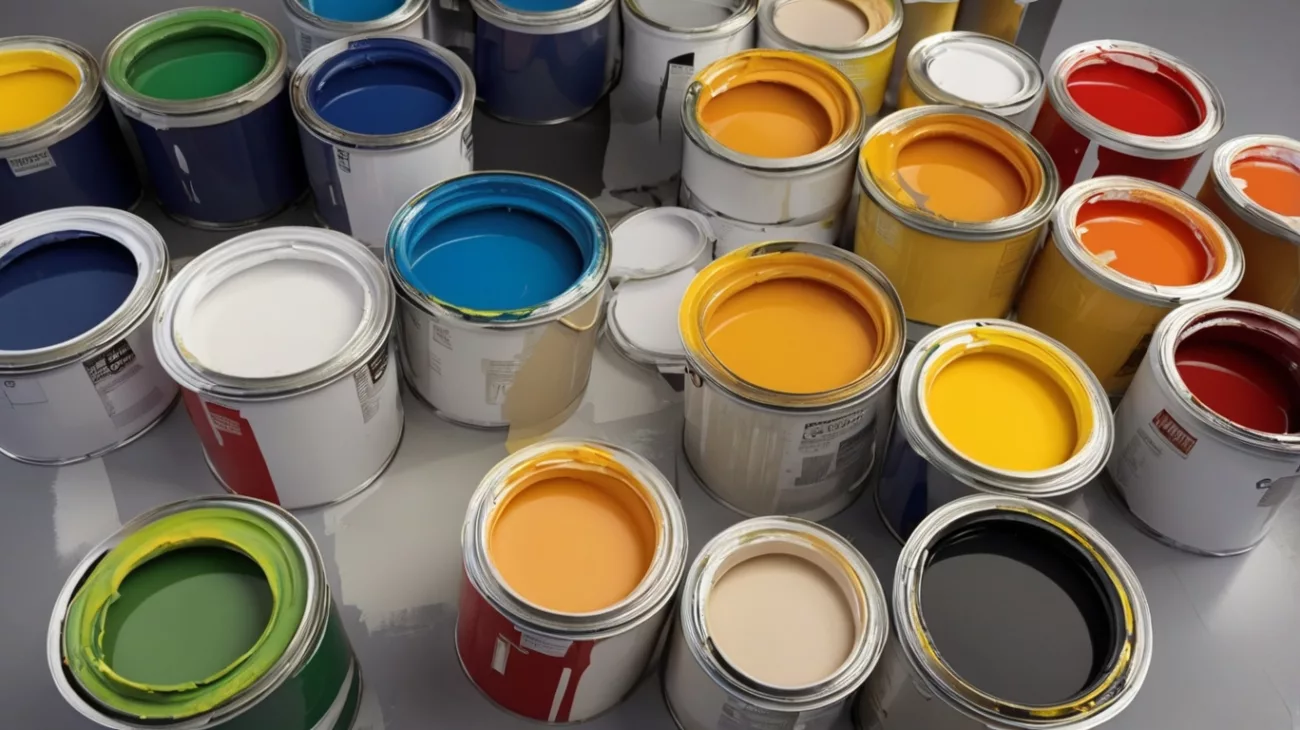Home Paints with Low VOCs: Healthier Living
Home paints with low VOCs are revolutionizing how we approach indoor air quality and environmental sustainability. When you choose low VOC paints for your living spaces, you’re making a conscious decision that impacts not just the aesthetic appeal of your home, but also the health of your family and the planet. This comprehensive guide explores everything you need to know about low VOC paints, their benefits, applications, and how they contribute to healthier living environments.
Understanding VOCs and Their Impact on Indoor Air Quality
Volatile Organic Compounds, commonly known as VOCs, are chemicals that evaporate at room temperature and release gases into the air. Traditional paints contain high levels of these compounds, which continue to off-gas long after the paint has dried. Home paints with low VOCs offer a safer alternative by significantly reducing these harmful emissions.
What Exactly Are VOCs?
VOCs encompass a wide range of chemicals, including formaldehyde, benzene, and toluene, among many others. In conventional paints, these compounds help with application properties, drying time, and durability. However, they come with serious downsides. When you apply standard paint to your walls, these chemicals don’t just disappear once the paint dries – they continue to release into your home’s air for years, albeit at decreasing rates.
Health Risks Associated with High-VOC Paints
The health implications of prolonged exposure to VOCs from traditional paints cannot be overstated. Research has consistently linked these chemicals to:
- Respiratory issues including asthma and bronchitis
- Eye, nose, and throat irritation
- Headaches and dizziness
- Nausea and fatigue
- Liver and kidney damage with long-term exposure
- Potential neurological effects
For vulnerable populations such as children, the elderly, and those with pre-existing health conditions, these risks are even more pronounced. Home paints with low VOCs minimize these risks by drastically reducing the amount of harmful chemicals released into your living space.
Environmental Impact of VOCs
Beyond personal health concerns, VOCs contribute significantly to environmental pollution. When these compounds enter the atmosphere, they react with nitrogen oxides and sunlight to form ground-level ozone, a major component of smog. This pollution damages plant life, reduces agricultural yields, and contributes to climate change.
By choosing home paints with low VOCs, you’re making an environmentally responsible decision that helps reduce this form of pollution. The lower emissions mean less contribution to smog formation and air quality degradation in your community and beyond.
The Science Behind Low-VOC Paint Formulations
Home paints with low VOCs represent a significant technological advancement in the coatings industry. Understanding how these formulations work can help you make more informed decisions about the products you bring into your home.
How Traditional Paints Are Formulated
Conventional paints typically consist of four main components:
- Pigments: Provide color and hiding power
- Binders: Hold the pigment particles together and adhere to surfaces
- Solvents: Keep the paint in liquid form until application
- Additives: Enhance specific properties like durability or mold resistance
In traditional oil-based paints, petroleum-derived solvents are the primary source of VOCs. Even water-based latex paints contain some VOCs, though usually at lower levels than their oil-based counterparts.
Low-VOC Paint Technology
Home paints with low VOCs use innovative formulation techniques to maintain performance while reducing harmful emissions:
- Water-based technology: Using water as the primary carrier instead of petroleum-based solvents
- Advanced polymer science: Creating binders that perform well without requiring high VOC content
- Alternative solvents: Utilizing compounds that maintain paint performance with lower emissions
- Innovative additives: Incorporating ingredients that enhance durability and application properties without increasing VOC content
What “Low-VOC” Actually Means
The term “low VOC” is regulated, but standards vary by region and certification body. In the United States, the Environmental Protection Agency (EPA) defines low-VOC interior paints as those containing less than 50 grams of VOCs per liter. However, other certification programs may have even stricter requirements:
- Green Seal GS-11 standard: Maximum 50 g/L for flat paints and 100 g/L for non-flat
- GREENGUARD: Focuses on overall emissions rather than just VOC content
- MPI Green Performance Standard: Multiple tiers of VOC restrictions
When shopping for home paints with low VOCs, it’s important to look for specific VOC content information and relevant certifications rather than just marketing claims.
Benefits of Using Home Paints with Low VOCs
The advantages of choosing low-VOC paints extend far beyond basic environmental considerations. These modern formulations offer numerous benefits that make them increasingly the preferred choice for health-conscious homeowners.
Immediate Air Quality Improvements
Perhaps the most noticeable benefit of home paints with low VOCs is the immediate difference in air quality during and after painting. Unlike traditional paints that fill your home with strong chemical odors for days or even weeks, low-VOC options typically have minimal odor that dissipates quickly. This means:
- Less disruption to your daily life during painting projects
- Rooms that can be occupied sooner after painting
- Reduced need for extensive ventilation measures
- A more pleasant painting experience overall
For many homeowners, this reduction in harsh fumes alone makes the switch to low-VOC paints worthwhile.
Long-Term Health Benefits
The long-term health benefits of using home paints with low VOCs are substantial. By significantly reducing your exposure to harmful chemicals, these paints help create living environments that support rather than compromise your health:
- Fewer irritants that can trigger asthma or allergy symptoms
- Reduced chronic exposure to potentially carcinogenic compounds
- Lower levels of endocrine-disrupting chemicals that can affect hormonal balance
- Better sleep quality due to improved air quality
- Reduced risk of developing chemical sensitivities
For homes with children, pregnant women, or immunocompromised individuals, these health benefits are particularly valuable. Children’s developing respiratory systems are especially vulnerable to VOC exposure, making low-VOC paints an important consideration for nurseries and playrooms.
Performance Advantages
Modern home paints with low VOCs often perform as well as or better than their high-VOC counterparts. Years of research and development have led to formulations that offer:
- Excellent coverage and hiding power
- Superior adhesion to various surfaces
- Good flow and leveling for a smooth finish
- Durability and washability comparable to traditional paints
- Wide color selection and finish options
The myth that low-VOC paints don’t perform as well has been thoroughly debunked by advances in paint technology. Today’s options can meet or exceed performance expectations while providing health and environmental benefits.
Contributing to Sustainable Living

Choosing home paints with low VOCs aligns with broader sustainability goals. These products:
- Reduce your home’s overall environmental footprint
- Support manufacturers who prioritize sustainable practices
- Often use packaging with recycled content
- Can contribute to green building certifications like LEED
- May be manufactured using less energy-intensive processes
For environmentally conscious consumers, these sustainability aspects make low-VOC paints a natural choice for home improvement projects.
Types of Low-VOC Paints Available on the Market
The market for home paints with low VOCs has expanded dramatically in recent years, with options now available in virtually every category and price point. Understanding the different types can help you select the right product for your specific needs.
Water-Based Low-VOC Options
Water-based or latex paints have traditionally contained fewer VOCs than oil-based alternatives, and manufacturers have further reduced VOC content in many of these formulations:
- Acrylic latex: Versatile, durable, and available in low and zero-VOC formulations
- Vinyl acrylic: Economical options with good washability
- 100% acrylic: Premium options with excellent adhesion and durability
These water-based home paints with low VOCs represent the majority of the market and are suitable for most interior applications.
Natural and Plant-Based Paints
For those seeking the absolute lowest VOC emissions, natural paints offer an alternative approach:
- Milk paints: Made from milk protein (casein), lime, clay, and natural pigments
- Clay paints: Formulated with clay and natural binders
- Plant-based paints: Utilizing oils and resins from renewable plant sources
These natural alternatives to conventional home paints with low VOCs often contain zero petrochemicals and can be particularly suitable for those with extreme chemical sensitivities. However, they may have different application characteristics and durability compared to conventional formulations.
Mineral-Based Options
Mineral paints represent another category of home paints with low VOCs:
- Silicate paints: Containing potassium silicate that chemically bonds with mineral substrates
- Limewash: Traditional formula made from slaked lime and natural pigments
- Ceramic-based paints: Utilizing ceramic microspheres for insulating properties
These options are especially well-suited for historic preservation projects and can offer excellent durability and breathability.
Specialty Low-VOC Products
Beyond basic wall paints, the low-VOC revolution has extended to specialty coatings:
- Trim and cabinet paints: Durable, self-leveling options for woodwork
- Floor paints: Hard-wearing formulations for concrete and wood floors
- Ceiling paints: Specialized products with minimal splatter
- Primers: Sealing and adhesion-promoting undercoats
- Exterior paints: Weather-resistant options for outdoor applications
This broad availability means you can complete entire painting projects using only home paints with low VOCs, without compromising on specialized performance needs.
How to Choose the Right Low-VOC Paint for Your Project
Selecting the optimal home paints with low VOCs requires considering several factors beyond just VOC content. This section guides you through the decision-making process to ensure you get the best results for your specific situation.
Assessing Your Specific Needs
Before shopping for home paints with low VOCs, consider:
- The surface being painted (drywall, wood, metal, previously painted surfaces)
- The room’s function (high-traffic areas require more durable finishes)
- Moisture exposure (bathrooms and kitchens need mold-resistant formulations)
- Desired finish (flat, eggshell, satin, semi-gloss, gloss)
- Color intensity (deeper colors may require different formulations)
- Budget constraints (prices vary widely among low-VOC options)
These factors will help narrow your choices to products specifically designed for your application.
Understanding VOC Content Labels and Certifications
When evaluating home paints with low VOCs, look beyond marketing claims to specific metrics and third-party certifications:
- Actual VOC content in grams per liter (g/L)
- Green Seal certification
- GREENGUARD certification
- MPI Green Performance rating
- EPA Safer Choice label
- Environmental Product Declarations (EPDs)
Remember that “low-VOC” and “zero-VOC” have specific regulatory definitions. In the U.S., paints labeled “zero-VOC” can still contain up to 5 g/L of VOCs, while “low-VOC” typically means less than 50 g/L for flat paints.
Brands Leading in Low-VOC Innovation
Several manufacturers have established themselves as leaders in the home paints with low VOCs category:
- Benjamin Moore Natura: Zero-VOC line with asthma & allergy friendly certification
- Sherwin-Williams Harmony: Low-VOC paint that actively helps reduce indoor air pollutants
- Behr Premium Plus: Budget-friendly low-VOC option widely available at home improvement stores
- AFM Safecoat: Specifically designed for chemically sensitive individuals
- ECOS Paints: Claims to be the least toxic paint available with full ingredient disclosure
- Clare: Direct-to-consumer brand with zero-VOC formulations and curated color selection
These manufacturers have invested significantly in research and development to create high-performing home paints with low VOCs that don’t compromise on quality or color selection.
Cost Considerations
While home paints with low VOCs sometimes carry premium pricing compared to conventional alternatives, the price gap has narrowed considerably as production has scaled up and consumer demand has increased. When evaluating costs:
- Consider the total cost of ownership, including fewer repaints due to better durability
- Factor in health benefits that may reduce medical costs
- Look for manufacturer rebates or incentives for choosing environmentally preferred products
- Compare cost per square foot coverage rather than just price per gallon
- Remember that higher-quality paints often require fewer coats, reducing overall material needs
Many homeowners find that the modest price premium for quality home paints with low VOCs is easily justified by the health and performance benefits.
Application Best Practices for Low-VOC Paints
Getting the best results from home paints with low VOCs requires understanding how their application may differ from conventional products. Follow these guidelines to ensure optimal performance and appearance.
Surface Preparation Techniques
Proper preparation remains essential when using home paints with low VOCs:
- Clean surfaces thoroughly to remove dirt, grease, and contaminants
- Repair any damage with appropriate patching compounds
- Sand surfaces for proper adhesion, creating a slightly rough profile
- Remove all dust with tack cloths or damp rags
- Apply appropriate primers designed for low-VOC systems
Many manufacturers offer low-VOC primers specifically formulated to work with their finish coats. Using compatible systems ensures the best adhesion and longevity.
Application Methods and Tools
Home paints with low VOCs may have different working properties than conventional paints:
- Many low-VOC formulations dry faster, requiring efficient application techniques
- Quality brushes and rollers become more important for achieving smooth finishes
- Airless sprayers may need adjusted settings for optimal atomization
- Temperature and humidity ranges for application may be narrower
Following manufacturer recommendations for application tools and techniques is particularly important with these advanced formulations.
Ventilation Requirements
While home paints with low VOCs produce fewer harmful emissions, proper ventilation during application remains important:
- Open windows and doors to create cross-ventilation when possible
- Use fans to circulate air and speed drying
- Continue ventilation for 24-48 hours after application for best results
- Consider portable air purifiers with HEPA and activated carbon filters for additional air cleaning
Good ventilation not only reduces exposure to the minimal VOCs present but also helps ensure proper drying and curing of the paint film.
Drying and Curing Considerations
Understanding the difference between drying time and full curing is important when working with home paints with low VOCs:
- Drying refers to when the paint is dry to the touch and can be recoated
- Curing is the complete process of film formation and hardening
- Low-VOC paints may have different curing profiles than conventional products
- Full curing can take 2-4 weeks depending on formulation and conditions
Avoid harsh cleaning or scrubbing of newly painted surfaces until they have fully cured to prevent damage to the paint film.
Beyond Paint: Creating a Comprehensive Low-VOC Home Environment
Home paints with low VOCs represent just one aspect of creating a healthier indoor environment. For truly healthier living, consider addressing other sources of indoor air pollution.
Complementary Low-VOC Building Materials
Expand your low-emission approach to other materials:
- Flooring: Choose hardwood with low-VOC finishes, natural linoleum, or certified low-emission carpeting
- Cabinetry and furniture: Select items made with formaldehyde-free adhesives and low-VOC finishes
- Insulation: Opt for formaldehyde-free options like mineral wool or cotton batts
- Adhesives and caulks: Use low-VOC alternatives for all construction and repairs
- Window treatments: Select natural fabrics without chemical treatments
This holistic approach multiplies the benefits of using home paints with low VOCs by eliminating multiple sources of indoor air pollution.
Air Purification Strategies
Support your low-VOC choices with active air cleaning:
- HEPA air purifiers with activated carbon can remove remaining airborne contaminants
- Regular HVAC filter changes with high-MERV rated filters trap more particulates
- Indoor plants like peace lilies, spider plants, and snake plants can help filter some VOCs
- Proper humidity control prevents mold growth and improves overall air quality
- Regular ventilation brings in fresh outside air
These measures work synergistically with home paints with low VOCs to create the healthiest possible indoor environment.
Maintenance and Long-Term Care
Protect your investment in healthier living:
- Clean painted surfaces with mild, non-toxic cleaners to maintain finish integrity
- Address water damage promptly to prevent mold growth
- Keep records of paint types and colors used for future touch-ups
- Consider repainting high-wear areas before visible deterioration occurs
- Use low-VOC touch-up products for repairs and maintenance
Proper maintenance ensures your home paints with low VOCs continue to perform well throughout their lifecycle.
Case Studies: Real-World Applications of Low-VOC Paints

Examining how home paints with low VOCs have been successfully implemented in various settings provides valuable insights and inspiration for your own projects.
Residential Success Stories
Homeowners across the country have experienced tangible benefits after switching to home paints with low VOCs:
The Sullivan Family Renovation
After their youngest child developed asthma, the Sullivans renovated their 1990s home using exclusively low-VOC materials. Within months, they reported significant improvements in their child’s symptoms and fewer respiratory issues for the entire family.
Historic Home Preservation
When the Garcias restored their 1920s Craftsman bungalow, they chose specialized low-VOC formulations designed for heritage properties. The results preserved the home’s character while creating a healthier living environment than would have been possible with traditional restoration products.
New Construction Planning
The Patel family worked with their architect to specify low-VOC materials throughout their new home construction, including zero-VOC interior paints. They were able to move in almost immediately after construction completed, without the typical “new house smell” that often indicates high levels of chemical off-gassing.
Commercial Applications
Business environments have also benefited from using home paints with low VOCs in their spaces:
- Healthcare facilities reporting faster room turnover and patient satisfaction
- Schools documenting improved attendance after renovations with low-emission materials
- Office buildings noting productivity improvements after switching to healthier building materials
- Hotels marketing rooms as “allergy-friendly” after comprehensive low-VOC renovations
These commercial successes demonstrate that the benefits of home paints with low VOCs extend beyond residential applications.
Environmental Impact Assessments
Research has quantified the broader environmental benefits of widespread low-VOC paint adoption:
- Urban areas with strict VOC regulations have measured reductions in ground-level ozone
- Life cycle assessments show significantly lower environmental impact from low-VOC products
- Carbon footprint analyses demonstrate reduced emissions during manufacturing processes
- Health economic studies suggest substantial healthcare cost savings from improved indoor air quality
These metrics provide compelling evidence for the collective impact of individual choices to use home paints with low VOCs.
The Future of Low-VOC Paint Technology

The evolution of home paints with low VOCs continues at a rapid pace, with exciting innovations on the horizon.
Emerging Technologies in Paint Formulation
Research and development efforts are focused on:
- Bio-based materials derived from agricultural waste products
- Self-cleaning surfaces that reduce the need for chemical cleaners
- Air-purifying additives that actively break down pollutants
- Advanced polymer science enabling even better performance without harmful ingredients
- Smart coatings that respond to environmental conditions
These technologies promise to make future home paints with low VOCs even more effective and environmentally friendly.
Regulatory Trends and Industry Changes
The regulatory landscape continues to evolve:
- Increasingly stringent VOC limits in many jurisdictions
- Expanded ingredient disclosure requirements
- Growing harmonization of standards across regions
- More comprehensive health-based evaluations beyond simple VOC content
- Industry voluntary initiatives exceeding regulatory requirements
These changes are driving manufacturers to innovate and reformulate their products, benefiting consumers seeking healthier options.
Consumer Advocacy and Education
Informed consumers are driving market transformation:
- Growing awareness of indoor air quality issues
- Increased demand for transparency in product formulations
- Consumer-led testing and reporting initiatives
- Social media sharing of experiences with home paints with low VOCs
- Community groups advocating for healthier building materials
This consumer pressure ensures continued improvement in the availability and performance of low-VOC options.
Conclusion: Making the Switch to Low-VOC Paints
Home paints with low VOCs represent a significant advancement in creating healthier living environments without sacrificing performance or aesthetics. By understanding the science behind these products, carefully selecting the right options for your specific needs, and following best practices for application, you can transform your home into a healthier space while reducing environmental impact.
The growing availability of high-quality, affordable home paints with low VOCs makes this an accessible change for virtually any homeowner or building manager. Whether you’re planning a full renovation, building new construction, or simply refreshing a room, choosing low-VOC paints is a meaningful step toward healthier living.
As technology continues to advance and awareness grows, we can expect even better options to emerge. By making informed choices today, you’re not only protecting your family’s health but also contributing to a larger movement toward healthier, more sustainable building practices.
Additional Resources
To learn more about home paints with low VOCs, consider these valuable resources:
- EPA Indoor Air Quality Guide
- Green Seal Paint Certification Standards
- Healthy Building Network
- American Lung Association Healthy Air Resources
- Environmental Working Group’s Building Material Guides
Disclaimer: While home paints with low VOCs significantly reduce exposure to harmful chemicals, individual sensitivities vary. Those with severe chemical sensitivities or specific health concerns should consult with healthcare providers before undertaking painting projects.
This article on home paints with low VOCs was last updated on April 21, 2025. For the most current information on product specifications and availability, please consult manufacturer websites and current regulatory guidelines.
Link to EPA Indoor Air Quality Guidelines
Link to American Lung Association Resources
Internal Link: Related Article on Eco-Friendly Home Renovations







